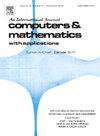A novel meshfree method for free vibration behavior of the functionally graded carbon nanotube-reinforced composite plates using a new shear deformation theory
IF 2.9
2区 数学
Q1 MATHEMATICS, APPLIED
引用次数: 0
Abstract
This study investigates the free vibration behavior of functionally graded carbon nanotube-reinforced composite (FG-CNTRC) plates using a novel approach. This approach employs Chebyshev polynomials to represent both new shear deformation theory and moving Kriging meshfree shape functions. The proposed theory, termed the third-order Chebyshev shear deformation theory (TCSDT), automatically fulfills the zero of shear stresses on the top and bottom surfaces. To improve the accuracy of the solution, Chebyshev polynomials are replaced by the traditional polynomials to construct a new set of Chebyshev-based moving Kriging meshfree shape functions. Besides, the FG-CNTRC plate consists of a matrix material reinforced with carbon nanotubes (CNTs), distributed in a graded manner along the thickness direction, with four distribution types: uniform (FG-UD), V distribution (FG-V), O distribution (FG-O), and X distribution (FG-X). The equilibrium equations are derived using TCSDT in conjunction with the principle of virtual work and are subsequently solved using the Chebyshev moving Kriging (CMK) meshfree method. The numerical outcomes are compared with the reference solution, showing good agreement. Furthermore, the impact of the CNTs volume fraction, CNTs distribution, and geometry on the free vibration of the FG-CNTRC plates are examined.
基于剪切变形理论的功能梯度碳纳米管增强复合材料板自由振动特性无网格分析方法
本文采用一种新颖的方法研究了功能梯度碳纳米管增强复合材料(FG-CNTRC)板的自由振动行为。该方法采用切比雪夫多项式来表示新的剪切变形理论和移动克里格无网格形状函数。提出的理论被称为三阶切比雪夫剪切变形理论(TCSDT),该理论自动实现了上下表面剪应力的零。为了提高解的精度,将切比雪夫多项式替换为传统多项式,构造了一组新的基于切比雪夫的运动克里格无网格形状函数。此外,FG-CNTRC板由碳纳米管增强的基体材料组成,沿厚度方向呈梯度分布,分布类型为均匀分布(FG-UD)、V型分布(FG-V)、O型分布(FG-O)和X型分布(FG-X)。利用TCSDT结合虚功原理推导了平衡方程,并用切比雪夫移动克里金(CMK)无网格法求解。数值计算结果与参考解进行了比较,结果吻合较好。此外,研究了CNTs体积分数、CNTs分布和几何形状对FG-CNTRC板自由振动的影响。
本文章由计算机程序翻译,如有差异,请以英文原文为准。
求助全文
约1分钟内获得全文
求助全文
来源期刊

Computers & Mathematics with Applications
工程技术-计算机:跨学科应用
CiteScore
5.10
自引率
10.30%
发文量
396
审稿时长
9.9 weeks
期刊介绍:
Computers & Mathematics with Applications provides a medium of exchange for those engaged in fields contributing to building successful simulations for science and engineering using Partial Differential Equations (PDEs).
 求助内容:
求助内容: 应助结果提醒方式:
应助结果提醒方式:


